Analysis of the Influence and Mechanism of Diatomaceous Earth Internal Curing on the Autogenous Shrinkage and Early Crack Resistance of Cement-Based Materials with Low Water–Binder Ratio
Abstract
:1. Introduction
2. Materials and Methods
2.1. Materials
2.2. Methods
2.2.1. Mechanical Properties Test
2.2.2. Internal Relative Humidity Test
2.2.3. Autogenous Shrinkage Experiment
2.2.4. Ring Anti-Cracking Experiment
2.2.5. Micro-Experiment Methods
3. Results
3.1. Mortar Mix Ratio and Compressive and Flexural Strength
3.2. Variation in Relative Humidity Inside Mortar
3.3. Autogenous Shrinkage Performance of Mortar
3.4. Early Cracking Resistance of Mortar
3.5. The Effect of DE on the Hydration Process of Cement Mortar
3.5.1. The Influence of DE on the Chemically Bound Water Content of Cement Mortar
3.5.2. The Impact of DE on the Phase Composition of Hydration Products in Cement Mortar
3.5.3. Effect of DE on the Micromorphology of Hydration Products of Cement Mortar
3.5.4. Effect of DE on the Pore Structure of Cement Mortar
3.6. Shrinkage Reduction Mechanism of DE
- (1)
- SiO2 and Al2O3 in DE can undergo secondary hydration reactions with Ca(OH)2 to produce hydration products such as C-S-H and expansion-type AFt, compensating for some of the shrinkage. SiO2 and Al2O3 in DE have high contents and can react with Ca(OH)2 to produce ettringite, which prolongs the secondary expansion period of mortar autogenous shrinkage.
- (2)
- Replacing part of the cement with DE reduces the activity of the cementing material, thus reducing autogenous shrinkage from the source. Autogenous shrinkage is caused by the hydration of cementing materials such as cement. Although the main component of DE is silicon dioxide, its limited activity allows it to participate in some hydration reactions.
- (3)
- The slow release of water in DE increases the relative humidity inside the cement mortar and reduces the driving force of autogenous shrinkage. DE contains a large number of tiny pores and has good water absorption and release properties, which enable it to slowly release water during the hardening process of cement mortar, thereby increasing the internal relative humidity of cement mortar (see Figure 4) and reducing the driving force of autogenous shrinkage.
4. Conclusions
- (1)
- The unique natural macroporous/mesoporous structure of DE endows it with excellent water absorption and release properties, which can improve the internal relative humidity of mortar and significantly slow down the decline rate of internal relative humidity. Compared to the benchmark group, when the content of DE is 1%, the saturation duration of the internal humidity of mortar is extended by 3.4%.
- (2)
- Under the standard of not reducing the 28 d compressive strength of mortar, compared to the reference group, the mortar mix proportion of DE replacing 1% cement mass reduces the 3 d autogenous shrinkage value by 30.9% and the 7 d autogenous shrinkage value by 36.7%. In the ring-constrained crack resistance test, the initial cracking time is delayed by 10.7%, and the crack width is reduced by 28%.
- (3)
- The mechanism of DE reducing autogenous shrinkage comprises in three aspects. Firstly, SiO2 and Al2O3 in DE react with Ca(OH)2 to produce expansive ettringite, which compensates for part of the shrinkage. Secondly, DE replaces part of the cement, reducing the activity of cementing materials and thus reducing autogenous shrinkage from the source. Thirdly, the slow release of water from its porous structure can increase the internal relative humidity of mortar and reduce the driving force of autogenous shrinkage.
Author Contributions
Funding
Institutional Review Board Statement
Informed Consent Statement
Data Availability Statement
Conflicts of Interest
References
- Menna, C.; Mata-Falcón, J.; Bos, F.P.; Vantyghem, G.; Ferrara, L.; Asprone, D.; Salet, T.; Kaufmann, W. Opportunities and challenges for structural engineering of digitally fabricated concrete. Cem. Concrete Res. 2020, 133, 106079. [Google Scholar] [CrossRef]
- Rong, Z.; Sun, W.; Xiao, H.; Wang, W. Effect of silica fume and fly ash on hydration and microstructure evolution of cement based composites at low water-binder ratios. Constr. Build. Mater. 2014, 51, 446–450. [Google Scholar] [CrossRef]
- Maruyama, I.; Teramoto, A. Temperature dependence of autogenous shrinkage of silica fume cement pastes with a very low water-binder ratio. Cem. Concr. Res. 2013, 50, 41–50. [Google Scholar] [CrossRef]
- Liu, J.; Shi, C.; Ma, X.; Khayat, K.H.; Zhang, J.; Wang, D. An overview on the effect of internal curing on shrinkage of high performance cement-based materials. Constr. Build. Mater. 2017, 146, 702–712. [Google Scholar] [CrossRef]
- Miao, Y.; Lu, Z.; Wang, F.; Wang, H.; Li, Y.; Lin, J.; Jiang, J. Shrinkage cracking evolvement in concrete cured under low relative humidity and its relationship with mechanical development. J. Build. Eng. 2023, 72, 106670. [Google Scholar] [CrossRef]
- Ramaglia, G.; Lignola, G.P.; Fabbrocino, F.; Prota, A. Numerical modelling of masonry barrel vaults reinforced with textile reinforced mortars. Key Eng. Mater. 2017, 747, 11–19. [Google Scholar] [CrossRef]
- Kumar, S.V.; GangaRao, H.V.S. Fatigue Response of Concrete Decks Reinforced with FRP Rebars. J. Struct. Eng. 1998, 124, 11–16. [Google Scholar] [CrossRef]
- Schutter, G.D. Durability of Marine Concrete Structures Damaged by Early age Thermal Cracking. In International RILEM Workshop on Life Prediction and Aging Management of Concrete Structures; Naus, D., Ed.; RILEM: Paris, France, 2000; pp. 177–186. [Google Scholar]
- Huang, Y.; Chen, G.; Yang, R.; Yu, R.; Xiao, R.; Wang, Z.; Xie, G.; Cheng, J. Hydration kinetics and microstructure development of Ultra-High Performance Concrete (UHPC) by high volume of phosphorus slag powder. Cem. Concr. Compos. 2023, 138, 104978. [Google Scholar] [CrossRef]
- Mamo, G.; Mattiasson, B. Alkaliphiles: The Emerging Biological Tools Enhancing Concrete Durability. Adv. Biochem. Eng./Biotechnol. 2020, 172, 293–342. [Google Scholar]
- Zeng, Y.; Li, X.; Jiang, D.; Ran, J. Study on the Effects of Innovative Curing Combinations on the Early Temperature Field of Concrete Box Girders. Buildings 2022, 12, 1808. [Google Scholar] [CrossRef]
- Tran, N.P.; Gunasekara, C.; Law, D.W.; Houshyar, S.; Setunge, S.; Cwirzen, A. A critical review on drying shrinkage mitigation strategies in cement-based materials. J. Build. Eng. 2021, 38, 102210. [Google Scholar] [CrossRef]
- Meddah, M.S.; Sato, R. Effect of curing methods on autogenous shrinkage and self-induced stress of high-performance concrete. ACI Mater. J. 2010, 107, 65–74. [Google Scholar]
- Lura, P. Autogenous Deformation and Internal Curing of Concrete. Ph.D. Thesis, Delft University of Technology, Delft, The Netherlands, 2003. [Google Scholar]
- Jensen, O.M.; Hansen, P.F. Water-entrained cement-based materials: II. Experimental observations. Cem. Concr. Res. 2002, 32, 973–978. [Google Scholar] [CrossRef]
- Igarashi, S.; Watanabe, A. Experimental study on prevention of autogenous deformation by internal curing using super-absorbent polymer particles. In Proceedings of the International RILEM Conference on Volume Changes of Hardening Concrete: Testing and Mitigation, Lyngby, Denmark, 20–23 August 2006; pp. 77–86. [Google Scholar]
- Lura, P.; Durand, F.; Jensen, O.M. Autogenous strain of cement pastes with superabsorbent polymers. In Proceedings of the International RILEM Conference on Volume Changes of Hardening Concrete: Testing and Mitigation, Lyngby, Denmark, 20–23 August 2006; RILEM Publications SARL: Paris, France; pp. 57–65. [Google Scholar]
- Esteves, L.P. Internal Curing in Cement-Based Materials. Ph.D. Thesis, The University of Aveiro (UA), Aveiro, Portugal, 2009. [Google Scholar]
- Larianovsky, P. Internal Curing of Concrete Using Super-Absorbent Polymers. Master’s Thesis, Technion–Israel Institute of Technology, Haifa, Israel, 2007. [Google Scholar]
- Craeye, B.; Geirnaert, M.; De Schutter, G. Super absorbing polymers as an internal curing agent for mitigation of early-age cracking of high-performance concrete bridge decks. Constr. Build. Mater. 2011, 25, 1–13. [Google Scholar] [CrossRef]
- Hasholt, M.T.; Jensen, O.M.; Kovler, K.; Zhutovsky, S. Can superabsorent polymers mitigate autogenous shrinkage of internally cured concrete without compromising the strength? Constr. Build. Mater. 2012, 31, 226–230. [Google Scholar] [CrossRef]
- Ma, X.; Liu, J.; Shi, C. A review on the use of LWA as an internal curing agent of high performance cement-based materials. Constr. Build. Mater. 2019, 218, 385–393. [Google Scholar] [CrossRef]
- Kang, S.; Hong, S.; Moon, J. Importance of drying to control internal curing effects on field casting ultra-high performance concrete. Cem. Concr. Res. 2018, 108, 20–30. [Google Scholar] [CrossRef]
- Kang, S.; Hong, S.; Moon, J. The effect of superabsorbent polymer on various scale of pore structure in ultra-high performance concrete. Constr. Build. Mater. 2018, 172, 29–40. [Google Scholar] [CrossRef]
- Kang, S.; Hong, S.; Moon, J. Shrinkage characteristics of heat-treated ultra-high performance concrete and its mitigation using superabsorbent polymer based internal curing method. Cem. Concr. Compos. 2018, 89, 130–138. [Google Scholar] [CrossRef]
- Reka, A.A.; Pavlovski, B.; Fazlija, E.; Berisha, A.; Pacarizi, M.; Daghmehchi, M.; Sacalis, C.; Jovanovski, G.; Makreski, P.; Oral, A. Diatomaceous Earth: Characterization, thermal modification, and application. Open Chem. 2021, 19, 451–461. [Google Scholar] [CrossRef]
- Kontić, A.; Vasconcelos, G.; Melendez, C.B.; Azenha, M.; Sokolović, N. Influence of air entrainers on the properties of hydrated lime mortars. Constr. Build. Mater. 2023, 403, 132968. [Google Scholar] [CrossRef]
- Diaz, J.; Ševčík, R.; Mácová, P.; Menéndez, B.; Frankeová, D.; Slížková, Z. Impact of nanosilica on lime restoration mortars properties. J. Cult. Herit. 2022, 55, 210–220. [Google Scholar] [CrossRef]
- Chen, Z.; Liu, H.; Xu, L.; Ge, W. A review of mechanical properties and carbonation behavior evolution of lime mortar for architectural heritages restoration. Miner. Miner. Mater. 2024, 3, 3. [Google Scholar] [CrossRef]
- Saidi, T.; Hasan, M. The effect of partial replacement of cement with diatomaceous earth (DE) on the compressive strength and absorption of mortar. J. King Saud Univ. Eng. Sci. 2022, 34, 250–259. [Google Scholar] [CrossRef]
- Schröfl, C.; Mechtcherine, V.; Gorges, M. Relation between the molecular structure and the efficiency of superabsorbent polymers (SAP) as concrete admixture to mitigate autogenous shrinkage. Cem. Concr. Res. 2012, 42, 865–873. [Google Scholar] [CrossRef]
- GB/T 17671-2021; Test Method for Strength of Cementitious Sand (ISO Method). National Technical Committee for Cement Standardisation: Beijing, China, 2021.
- CCES 01-2004; Guidelines for the Design and Construction of Concrete Structures for Durability. China Civil Engineering Society Standard: Beijing, China, 2008.
- Lin, H. Practice Analysis of the Development Trend of Concrete Strength. Concr. World 2021, 8, 52–55. [Google Scholar]
- Han, Y.; Zhang, J.; Luosun, Y.; Hao, T. Effect of internal curing on internal relative humidity and shrinkage of high strength concrete slabs. Constr. Build. Mater. 2014, 61, 41–49. [Google Scholar] [CrossRef]
- Mounanga, P.; Baroghel-Bouny, V.; Loukili, A.; Khelidj, A. Autogenous deformations of cement pastes: Part I. Temperature effects at early age and micro–macro correlations. Cem. Concr. Res. 2006, 36, 110–122. [Google Scholar] [CrossRef]
- Ma, Y.; Li, W.; Jin, M.; Liu, J.; Zhang, J.; Huang, J.; Lu, C.; Zeng, H.; Wang, J.; Zhao, H.; et al. Influences of leaching on the composition, structure and morphology of calcium silicate hydrate (C–S–H) with different Ca/Si ratios. J. Build. Eng. 2022, 58, 105017. [Google Scholar] [CrossRef]
- Zheng, X.; Liu, K.; Gao, S.; Wang, F. Use of Zeolite as Both Internal Curing Agent and Supplementary Binder in Mortar. J. Mater. Civ. Eng. 2023, 35, 04023299. [Google Scholar] [CrossRef]
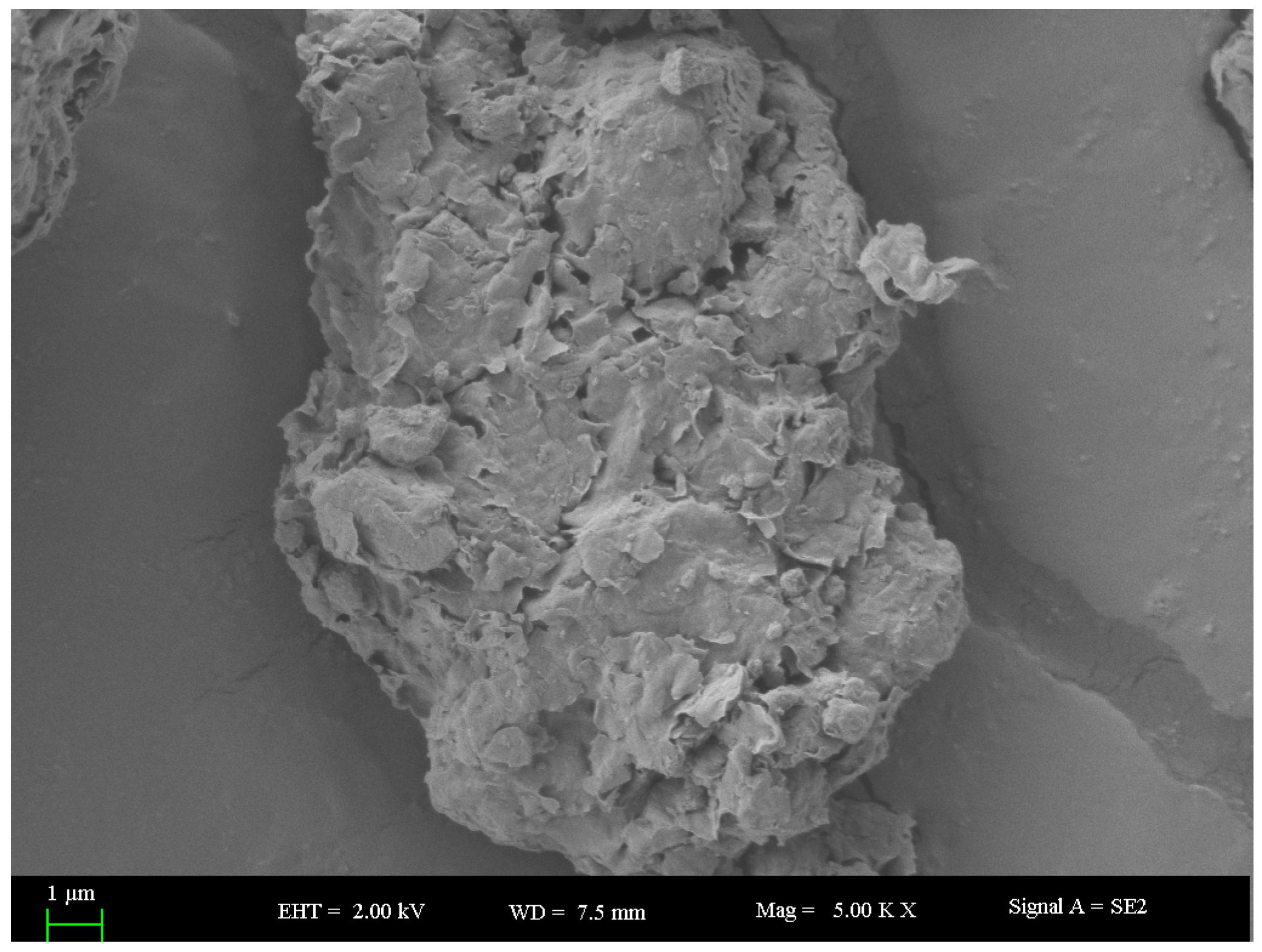
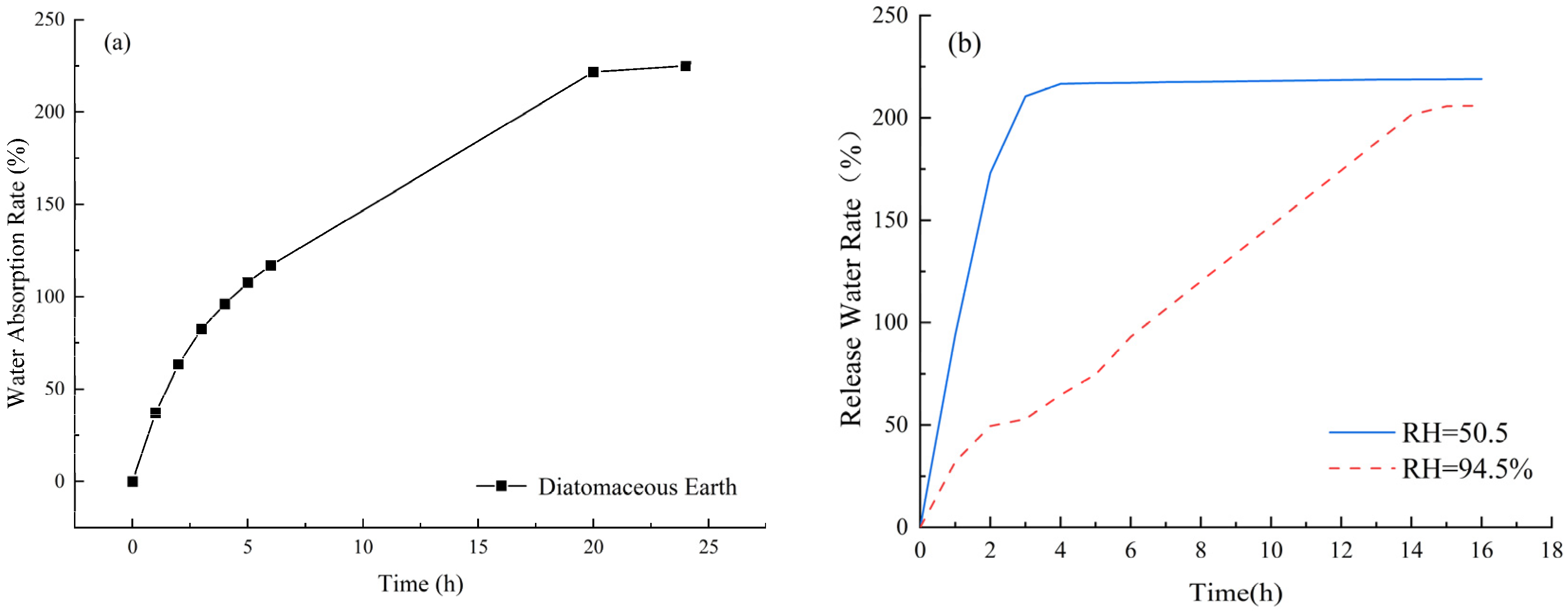
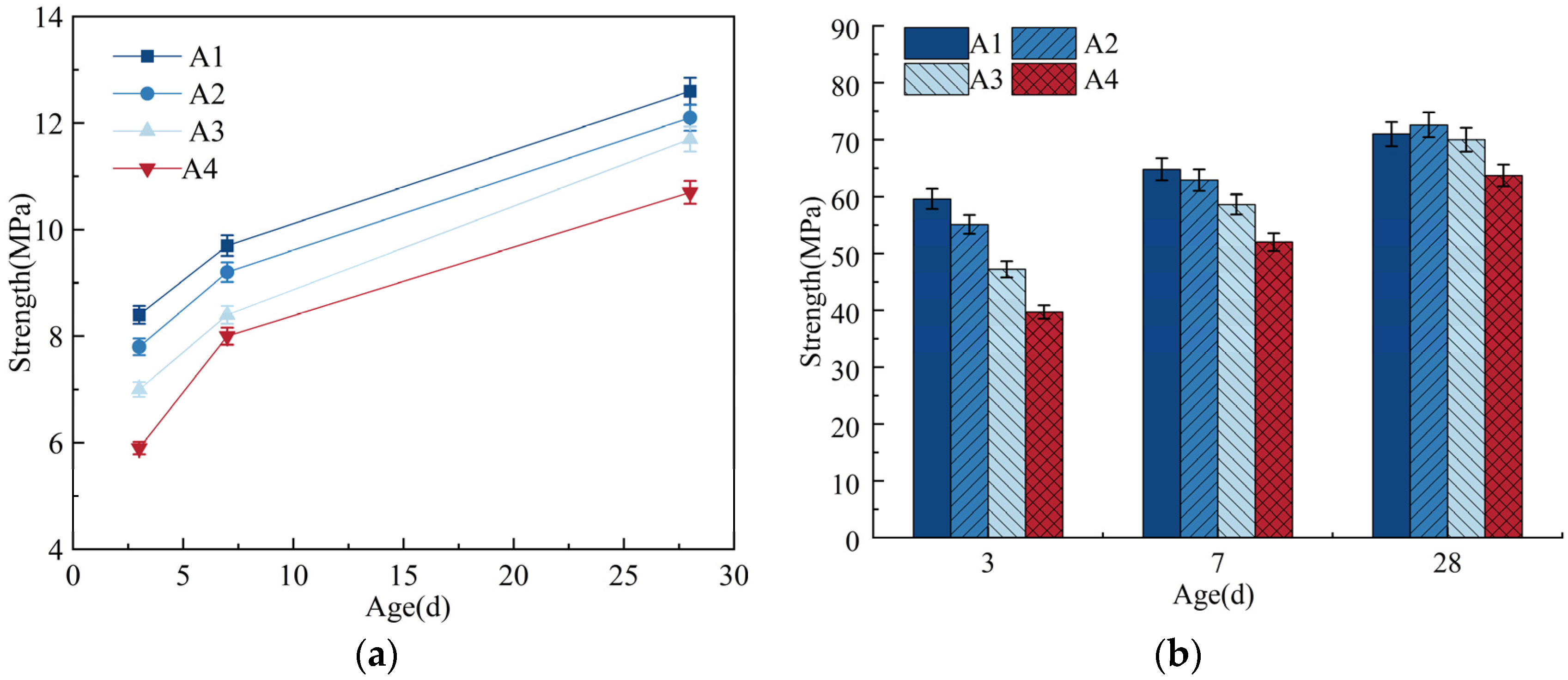

 Semi-wet DE:
Semi-wet DE:  Dry DE:
Dry DE:  , Direction of Water Release:
, Direction of Water Release:  .
.
 Semi-wet DE:
Semi-wet DE:  Dry DE:
Dry DE:  , Direction of Water Release:
, Direction of Water Release:  .
.



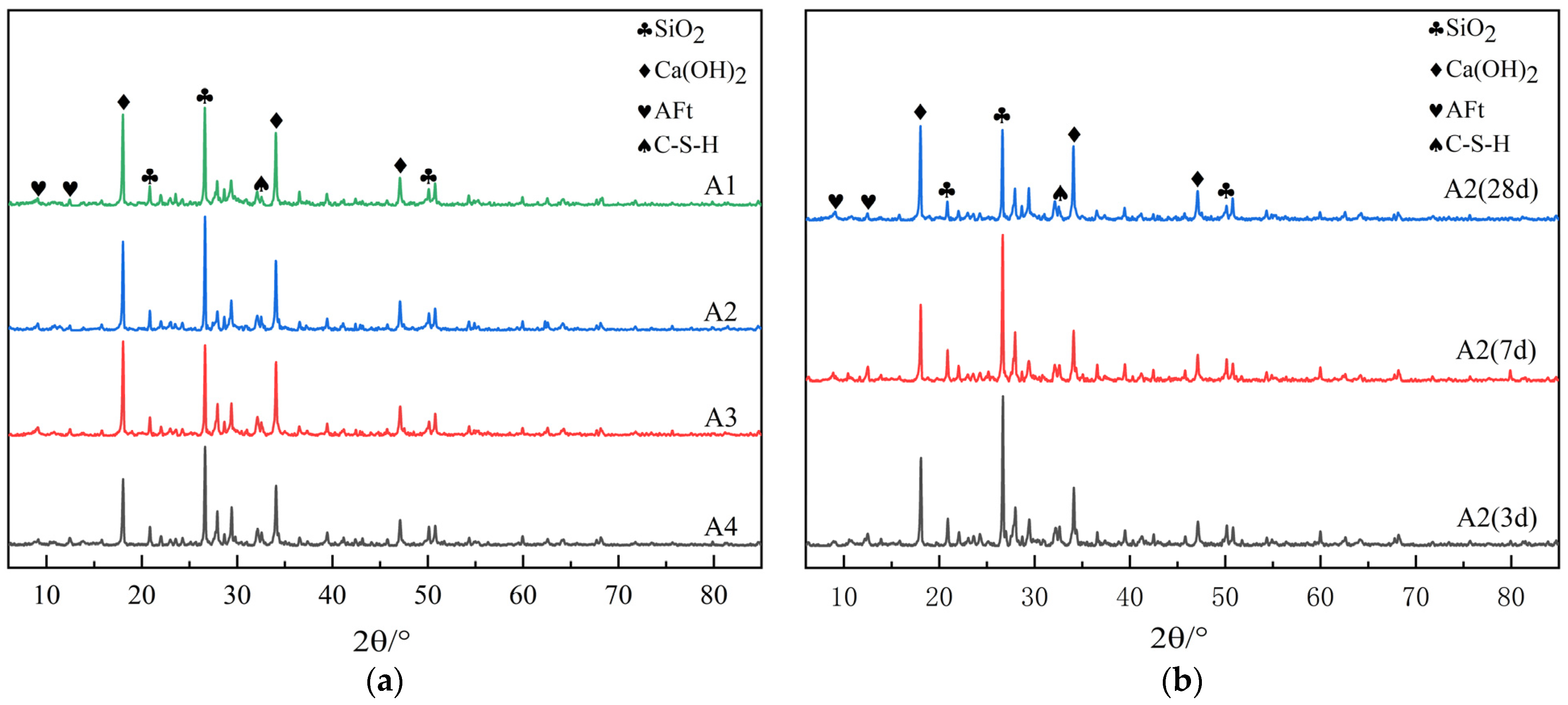

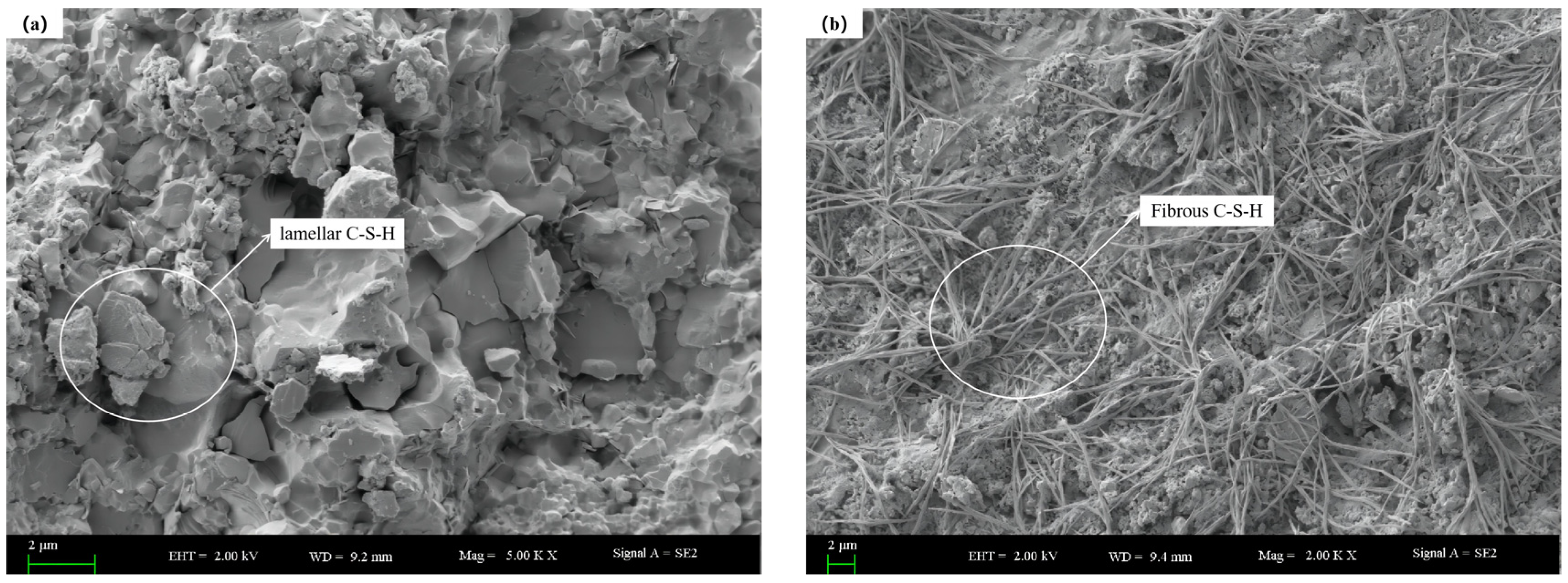
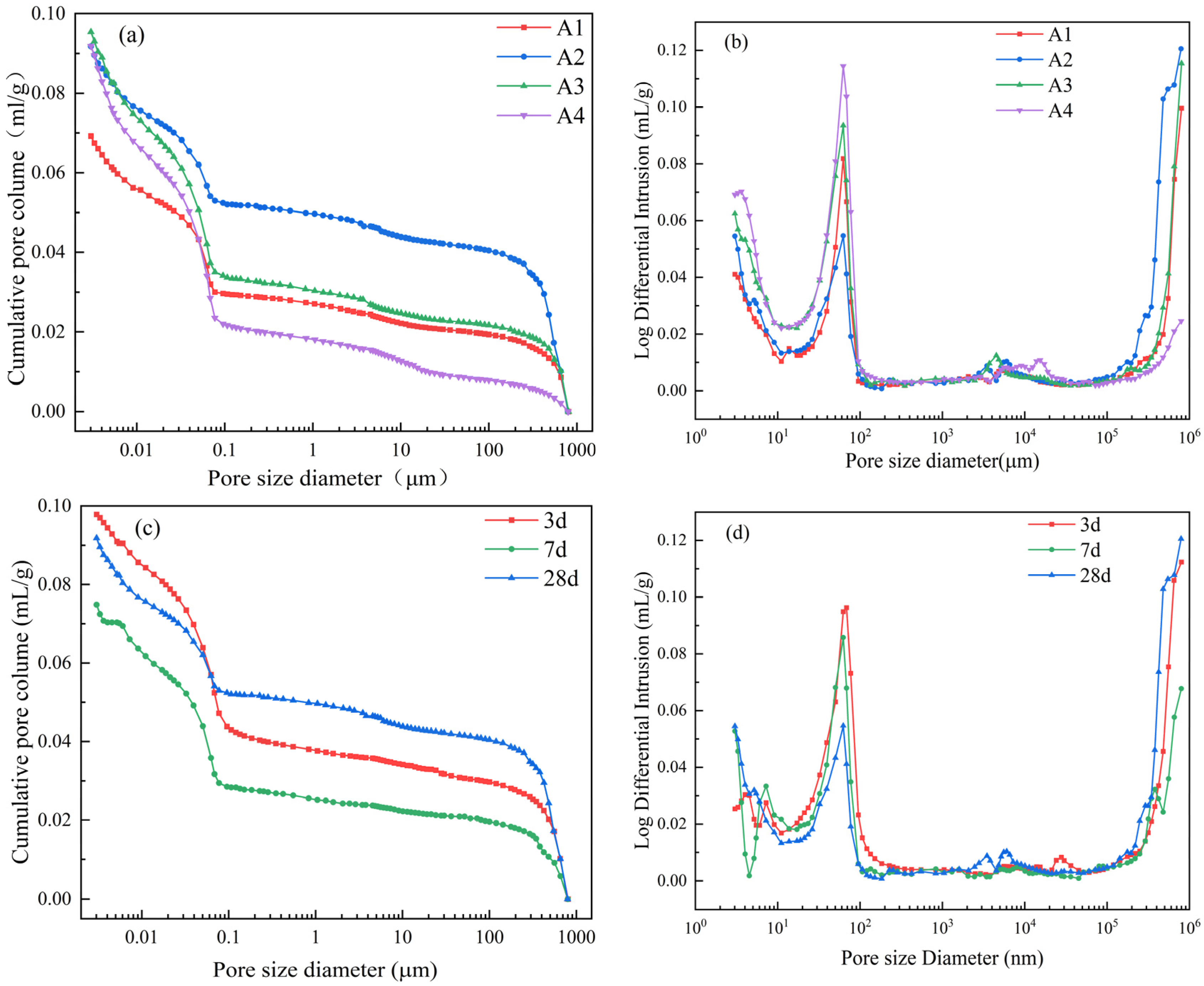
| Chemical Analysis | OPC (%) | DE (%) |
|---|---|---|
| SiO2 | 21.34 | 71.56 |
| Al2O3 | 4.86 | 14.87 |
| Fe2O3 | 3.56 | 1.57 |
| CaO | 63.92 | 4.16 |
| MgO | 1.78 | 4.95 |
| Na2O | 0.56 | 1.59 |
| Grouping | Actual Water–Binder Ratio (W/C) | Cement/% | DE/% | Water Reducer/% |
|---|---|---|---|---|
| A1 | 0.35 | 100 | 0 | 0.1 |
| A2 | 99 | 1 | 0.11 | |
| A3 | 97 | 3 | 0.12 | |
| A4 | 95 | 5 | 0.14 |
| Grouping | Porosity/% | Average Aperture/nm | Pore Size Distribution/(mL·g−1) | |||
|---|---|---|---|---|---|---|
| <10 nm | 10–100 nm | 100 nm–1 µm | >1 µm | |||
| A1 (28 d) | 14.05 | 19.01 | 0.0136 | 0.0262 | 0.0028 | 0.0267 |
| A2 (28 d) | 17.44 | 22.19 | 0.0162 | 0.0236 | 0.0024 | 0.0497 |
| A3 (28 d) | 17.88 | 16.47 | 0.0233 | 0.0397 | 0.0034 | 0.0299 |
| A4 (28 d) | 17.49 | 13.69 | 0.0257 | 0.0448 | 0.0037 | 0.0176 |
| A2 (3 d) | 19.02 | 26.13 | 0.0135 | 0.0419 | 0.0051 | 0.0373 |
| A2 (7 d) | 14.38 | 21.52 | 0.0131 | 0.0334 | 0.0033 | 0.0249 |
Disclaimer/Publisher’s Note: The statements, opinions and data contained in all publications are solely those of the individual author(s) and contributor(s) and not of MDPI and/or the editor(s). MDPI and/or the editor(s) disclaim responsibility for any injury to people or property resulting from any ideas, methods, instructions or products referred to in the content. |
© 2024 by the authors. Licensee MDPI, Basel, Switzerland. This article is an open access article distributed under the terms and conditions of the Creative Commons Attribution (CC BY) license (https://creativecommons.org/licenses/by/4.0/).
Share and Cite
Li, S.; Liu, S.; Jiang, C. Analysis of the Influence and Mechanism of Diatomaceous Earth Internal Curing on the Autogenous Shrinkage and Early Crack Resistance of Cement-Based Materials with Low Water–Binder Ratio. Appl. Sci. 2024, 14, 5397. https://doi.org/10.3390/app14135397
Li S, Liu S, Jiang C. Analysis of the Influence and Mechanism of Diatomaceous Earth Internal Curing on the Autogenous Shrinkage and Early Crack Resistance of Cement-Based Materials with Low Water–Binder Ratio. Applied Sciences. 2024; 14(13):5397. https://doi.org/10.3390/app14135397
Chicago/Turabian StyleLi, Shuangxi, Shunyi Liu, and Chunmeng Jiang. 2024. "Analysis of the Influence and Mechanism of Diatomaceous Earth Internal Curing on the Autogenous Shrinkage and Early Crack Resistance of Cement-Based Materials with Low Water–Binder Ratio" Applied Sciences 14, no. 13: 5397. https://doi.org/10.3390/app14135397





